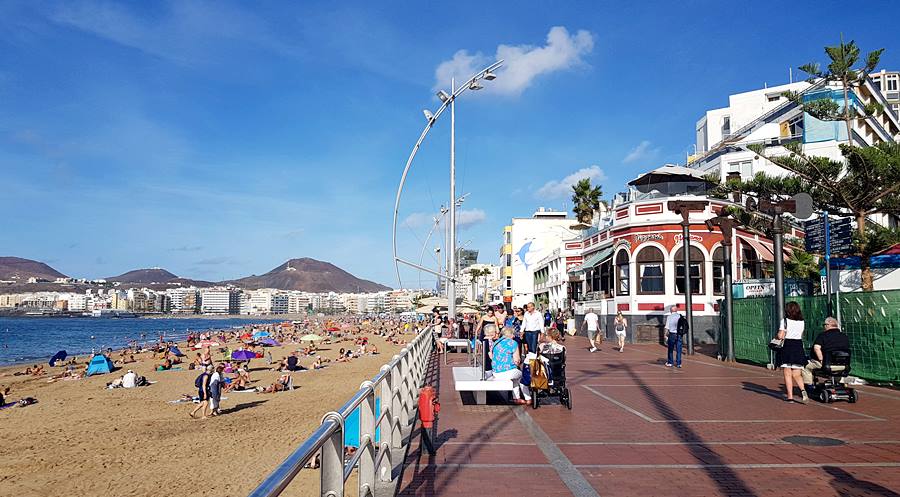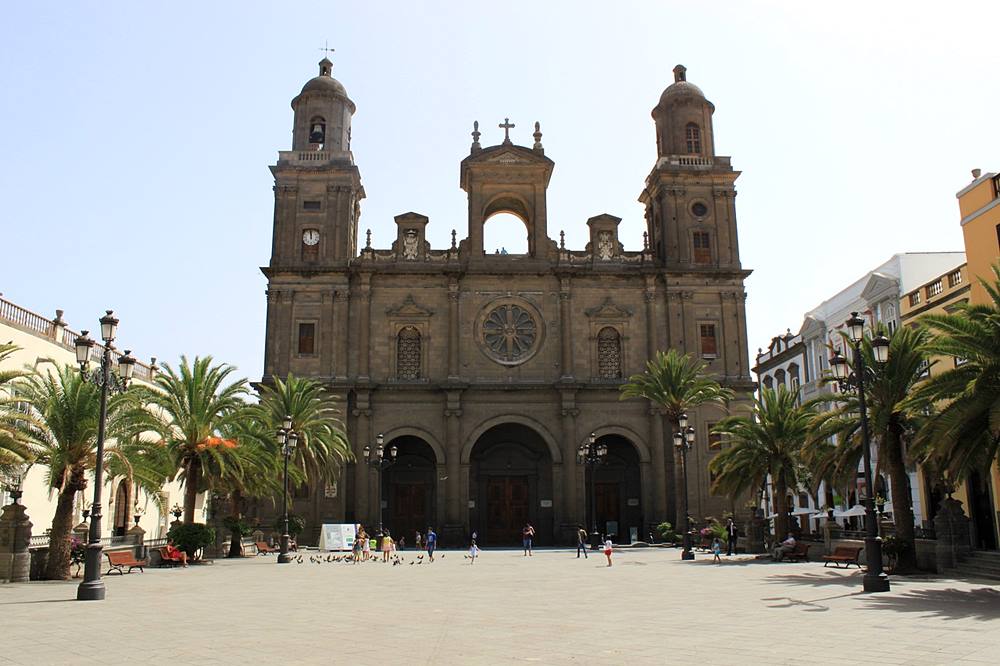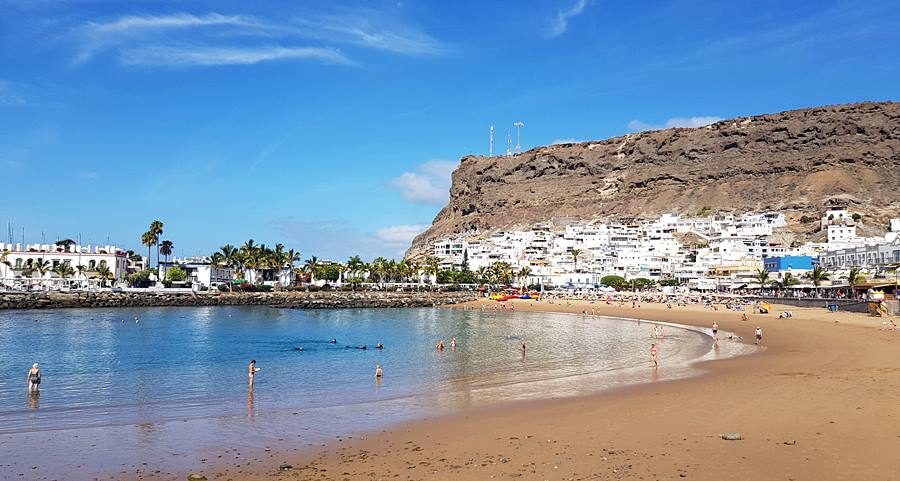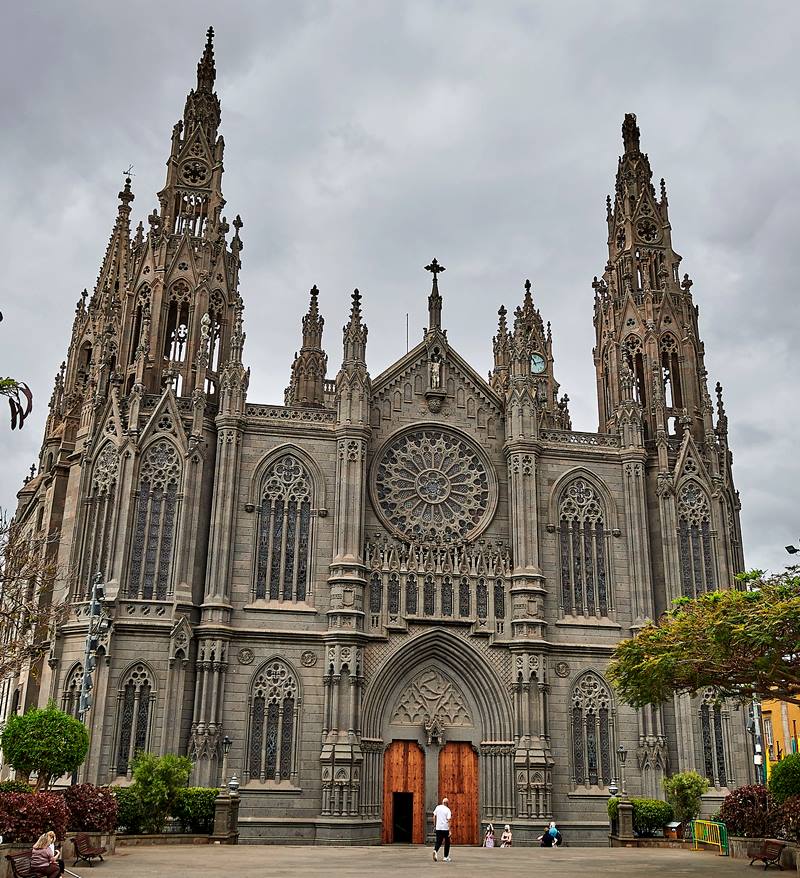Welcome to Las Palmas port (Gran Canaria cruise port), the main port and capital city of Gran Canaria (aka Grand Canary Island), the third-largest island of the Canary Islands archipelago. Las Palmas is a bustling and vibrant city with lots of shopping and dining opportunities, a beautiful city beach, and a historic old town. It is one of the most popular stops on the Canary Islands cruise.
Las Palmas de Gran Canaria, together with Santa Cruz de Tenerife, shares the status of the capital city of the autonomous community of the Canary Islands. In this article, I share with you:
- Gran Canaria cruise port info (Las Palmas cruise port, getting around, helpful cruise tips)
- Top 7 things to do in Gran Canaria cruise port and the best Gran Canaria shore excursions
Visit also our cruise port guides to Tenerife, Lanzarote, La Palma, Madeira, Lisbon, Gibraltar, Malaga
Gran Canaria Cruise Port (Las Palmas Port)
The Port of Las Palmas (Puerto de Las Palmas; La Luz Port) is the largest port in the Canary Islands handling passenger and commercial traffic for centuries. Cruise ships dock at the Muelle de Santa Catalina cruise terminal, within a short distance from some of the main sights. Las Palmas cruise terminal has two berths dedicated to cruise vessels and can simultaneously accommodate two large cruise liners.
Although Las Palmas’ old town (Vegueta) and city center are located 8 km/5 miles (a 10-minute drive) south of the Las Palmas port, you’ll find the area around the cruise port very attractive and entertaining. The area around the port is flat and wheelchair accessible, including the shopping streets, the waterfront promenade, and the city beach.

Within Walking Distance from the Port
There are many things you can do around the port itself if you choose to stay in the vicinity of Las Palmas port.
- Centro Comercial El Muelle – This large shopping mall is the first building you’ll spot on your right side upon exiting the cruise terminal area. It has several floors and features numerous clothing stores, perfumeries, shops, a supermarket and a food court on the top floor. Outside the mall, there is a nice outdoor coffee shop where you can enjoy local coffee with nice views of the ship. The prices in the mall are very reasonable, so if you plan to shop, make sure you check this place out.
- Parque Maritimo Santa Catalina – A small scenic park with palms is located a few minutes’ walk from the shopping mall and adjacent to Plaza de Canarias square where Santa Catalina bus station (also known as El Intercambiador de Santa Catalina or Estación Santa Catalina) is located.
- Santa Catalina Park (Parque de Santa Catalina) – Right across the street from Plaza de Canarias and the bus station, you’ll come across a large square and park with kids’ playgrounds, a tourist information center, street vendors, another bus station, and benches to sit and relax. The park is surrounded by hotels, the Elder Museum of Science and Technology, public buildings and dozens of streets packed with cafes, restaurants and shops. This is a lively area and I recommend exploring it, as it’s only a 10-minute walk from the cruise terminal.
- Elder Museum of Science and Technology – An interesting science museum with hands-on displays, a planetarium, and a 3D cinema.
- Las Canteras Beach (Playa de Las Canteras) – Once you have crossed Santa Catalina Park and continued to walk straight, after a few minutes walk you’ll reach one of the busiest areas in town – Las Canteras beach with its lively waterfront promenade. The scenic promenade is lined with eateries, cafes and shops, and here you can cycle, walk, sit and relax on the benches, or go swimming in the crystal clear waters of the Atlantic Ocean. The beach is popular for its soft, golden sand, snorkeling, and beautiful background made of volcanic hills. Sunbed and umbrella rentals are available in some parts of the beach.


Getting Around Las Palmas Port
- The port area is flat, suitable for people with walking difficulties/wheelchair users, and easy to navigate.
- It is very easy to get around the island by public bus. Gran Canaria has an efficient public bus network and buses are well-maintained, air-conditioned and run frequently. They are operated by two companies: Global, which has blue buses and operates all over the island, and Guaguas Municipales, which has yellow buses and primarily operates in the city of Las Palmas and its suburbs. “Guaguas” in Spanish stands for “buses”. The nearest bus ticket sales office is at Santa Catalina Park and there is also an option to purchase the ticket from the driver (it’s usually more expensive in this case). One of the main bus stations for both intercity and local routes in Las Palmas is the Santa Catalina bus stop, located next to the port (aka El Intercambiador de Santa Catalina/Estación Santa Catalina). There are many bus routes and fares are cheap.
- Taxis are available practically everywhere, they are white-colored and metered. They are very affordable compared to the rest of Europe and normally accept cards.
- Las Palmas de Gran Canaria Hop on Hop off bus tours are available and are a great way to explore the city and its surroundings. They include 11 stops at the city’s main districts and attractions including Santa Catalina Park, El Corte Inglés, Auditorio Alfredo Kraus, Vegueta Old Town (with the iconic Las Palmas Cathedral), Playa de Las Canteras and others. The nearest Hop on Hop off bus station is at Muelle de Santa Catalina, right outside the cruise terminal. You can check the Las Palmas Hop on Hop off bus tour deals and offers on Viator and Get Your Guide.
- The port of Las Palmas offers amazing and cheap shopping. Besides Centro Comercial El Muelle which is located next to the cruise terminal, you can also visit El Corte Inglés shopping mall, located a 15-minute walk south of the terminal.
- The Canary Islands are part of Spain and thus the European Union, however, they enjoy special fiscal status and are within a VAT-free zone, which means that everything is cheaper compared to the rest of Europe. If you plan to shop for perfumes, watches and jewelry, you’ll find great deals here.
- The currency in Spain is EURO (€). Local currency and credit cards are normally accepted, and there are ATMs and exchange currency around the town.
- Las Palmas de Gran Canaria Airport is located 27 km/17 miles (a 25-30 minute drive) south of Las Palmas port.
- Book a private transfer to/from Las Palmas cruise port
- Explore Las Palmas tours and activities
- Check out rent-a-car deals
- Book accommodation in Las Palmas
7 Best Things to Do in Gran Canaria Cruise Port
Before I share the best things to do in Gran Canaria, I invite you to grab your copy of the “Mediterranean Cruise Port Guide”, the most comprehensive guide to 45 Mediterranean cruise ports (including Las Palmas de Gran Canaria), packed with practical information, expert tips & unforgettable experiences! (PDF format/200 pages)
 A Comprehensive Guide to 45 Mediterranean Cruise Ports
Plan your cruise itinerary in less than an hour and maximize your port experience!
A Comprehensive Guide to 45 Mediterranean Cruise Ports
Plan your cruise itinerary in less than an hour and maximize your port experience!
1. Las Palmas Old Town (Vegueta)
Vegueta is the old town of Las Palmas de Gran Canaria and is located 8 km/5 miles (a 10-minute drive) south of the Las Palmas port. The origins of Vegueta date back to the 15th century when the Castillian army first came to the island and established a military base, which later developed into the town.
Vegueta is where you’ll find narrow cobblestone streets, centuries-old buildings, authentic Spanish architecture, quaint alleys, and plazas dotted with cafes, shops and eateries. Vegueta is centered around Santa Ana Cathedral, its main landmark, and you can explore it on foot as the majority of streets are completely pedestrianized. Due to its historical value, Vegueta has been declared a UNESCO World Heritage Site. These are the main attractions of Vegueta Old Town:
- Santa Ana Cathedral – Also known under the names Las Palmas Cathedral and Catedral de Canarias, the iconic cathedral is the most important religious building in the Canary Islands. Its construction started in the 1500s and took hundreds of years to complete. Santa Ana Cathedral is famous for its remarkable blend of neoclassic, gothic and renaissance architectural styles, and two towers from which you can enjoy the fantastic panoramic views of the city and coast.
- Santa Ana Square – Plaza de Santa Ana is a large yet simple tree-lined square in front of the cathedral, surrounded by government, religious and cultural institutions such as the Casas Consistoriales de Las Palmas de Gran Canaria (a town hall), Casa Regental, Episcopal Palace, Provincial Historic Archive, and others.
- Casa de Colón (aka Cristopher Columbus house) is one of the most beautiful and ornate buildings in Gran Canaria. This 500-year-old architectural treasure is nowadays a history museum dedicated to Cristopher Columbus’s ship life, voyages and his visit to the Canary Islands in the summer of 1492. The museum is located on the back side of the cathedral.
- San Antonio Abad hermitage – Located right across from Casa de Colón, the hermitage is one of the oldest churches in Gran Canaria known as the worship place of Cristopher Columbus before his voyage to the discovery of America.
- Canarian Museum (Museo Canario) – The museum is located a few minutes walk from the cathedral and holds artifacts and objects dedicated to the prehistory and history of the Canary Islands.
- Vegueta Market (Mercado de Vegueta) – One of the oldest markets in the Canary Islands offers a wide range of all kinds of fresh produce, including meats, fish, cheese, spices, exotic fruits, vegetables and local Gran Canarian specialties. There are plenty of shops, cafes and eateries inside the market and in the surrounding streets (Calle Pelota – “calle” means “street” in Spanish; Calle Mendizábal).
- Santo Domingo Square (Plaza de Santo Domingo) – The square is dominated by the 18th-century fountain and the church of the same name.
- Atlantic Center of Modern Art (Centro Atlántico de Arte Moderno – CAAM Museum) – This contemporary art museum is located on Los Balcones Street behind the cathedral and housed in a restored 18th-century building. It is a must-see for modern art fans!
Explore Vegueta tours and activities

2. Dunes of Maspalomas
Nestled on the south coast of the island, 56 km/35 miles (a 45-minute drive) southwest of the Las Palmas cruise port, Maspalomas is a resort town known for the Maspalomas Dunes nature reserve. The nature reserve stretches over 400 hectares and features vast sand dunes, spectacular beaches, palm grooves, La Charca Lagoon, and diverse birdlife.
The 19th-century Faro de Maspalomas (Maspalomas Lighthouse) is one of the main attractions and is located in a lively beachfront area at the western end of Maspalomas Beach.

Playa del Inglés, Playa des Maspalomas and Playa de Meloneras are popular for their soft golden sands, water sports (snorkeling, scuba diving, surfing, boating), swimming and sunbathing, and offer all the facilities you can think of! They are surrounded by world-class hotel resorts, endless shops, designer stores, cafes and upscale seafront restaurants offering local and international cuisine.
If you travel with kids, Holiday World amusement park and Aqualand Maspalomas Water Park are the top picks, while the adults can enjoy bustling nightlife and a variety of casinos, clubs and bars.
If you are looking for the best photo ops, make sure you visit the information center and lookout point (Dunas Mirador) in the Hotel Riu Palace on Playa del Inglés. From here, you can enjoy unmatched views of the dunes and take a walk through the dunes via several pathways. If you book a shore excursion to Maspalomas, this is usually one of the stops.
Explore Maspalomas tours and activities

3. Puerto de Mogán
Nestled in the municipality of Mogán on the southwest coast of Gran Canaria, Puerto de Mogán is a scenic resort town with a golden sand beach and picturesque marina lined with cafes, restaurants and shops. It is not crowded like Maspalomas and Las Palmas and offers visitors a great getaway from the hustle and bustle of the capital. The golden sand Playa Mogán is a popular swimming and sunbathing spot and offers all the necessary facilities for a perfect beach day. Puerto de Mogán is located 80 km/50 miles (a 1-hour drive) southwest of Las Palmas port.
Check out Puerto de Mogán tours and activities

4. Pico de las Nieves
Nestled in the heart of the island, at an altitude of 1,949 meters (6,394 ft), Pico de las Nieves is the second-highest peak on the island of Gran Canaria and a popular hiking destination. From Pico de las Nieves’s viewpoint, you can admire the magnificent views of the UNESCO Biosphere Reserve, with its spectacular rock formations, scenic valleys, pine forests, ridges and remote villages. On a clear day, you can also see Spain’s highest peak – Mount Teide on Tenerife island.
One of the main rock formations here is Roque Nublo, a striking 67-meter-tall volcanic rock and a former volcanic plug made up of red basalt. Pico de las Nieves viewpoint is often included in island tours and popular activities here are hiking and off-road driving. It takes about a 1-hour drive to get to Pico de las Nieves from the cruise port.
Explore Gran Canaria island tours and activities
5. Teror
This mountainous town is located around 24 km/15 miles (a 40-minute drive) southwest of Las Palmas port and is known for its rich historic and religious heritage. It’s one of the oldest towns in the Canary Islands founded after the appearance of the Virgin in the second half of the 15th century.
The main landmark of the town, the 18th-century Virgin of the Pine Basilica (Nuestra Señora del Pino), dominates Plaza del Pino and is dedicated to the Virgin of the Pine, patroness of the Gran Canaria. Calle Real de la Plaza is the most picturesque street dotted with authentic colorful facades and ornate balconies.
The Market of Teror (Mercadillo de Teror) takes place on Plaza del Pino every Sunday and offers a wide range of local goods and fresh produce. Besides its religious and historic landmarks, the town is also known for its pastry makers and bakers who are believed to make the best sweet treats on the whole island!
Explore the town of Teror tours and activities
6. Arucas
Arucas is another unique town located around 16 km/10 miles (a 25-minute drive) southwest of Las Palmas port. The town’s main landmark is the imposing Church of San Juan Bautista (Parroquia de San Juan Bautista de Arucas) – a neo-Gothic cathedral built in the early 1900s by local master masons entirely in Arucas stone. The church boasts magnificent stained glass windows and valuable paintings and sculptures made by local artists.
Other places of interest include Plaza de San Juan, Plaza de la Constitución with the Town Hall building, Arucas Municipal Museum, Municipal Market, the Botanical Gardens (Jardín de la Marquesa de Arucas), and Destilerías Arehucas (Rum Distillery). Make sure you taste the local rum, because this area has been producing rum since the 15th century!
Check out Arucas tours and activities

7. Dolphin and Whale Watching
If you want to explore the rich marine life of the Atlantic Ocean, hop on a boat that will take you to the open sea where you’ll get the chance to see whales and dolphins in their natural habitat! Water activities are very popular in Gran Canaria, including scuba diving, snorkeling, kayaking, surfing and boating, and you can book a tour based on your preferences and physical shape. Whatever you go for – get ready for an unforgettable experience as the coast of Gran Canaria and its waters are truly mesmerizing!
- Check out Dolphin and Whale Watching tours and activities
- Explore Gran Canaria water-related tours and activities
Visit also our cruise port guides to Barcelona, Valencia, Palma de Mallorca, La Coruna, Vigo, Cartagena, Cadiz, Alicante, Bilbao
You may also like our cruise port guides to the Mediterranean, Caribbean, Western Europe, Baltic & Scandinavia, USA & Canada, Australia & New Zealand
Don’t miss out on the opportunity to enhance your Mediterranean cruise experience with our “Mediterranean Cruise Port Guide“- your ultimate companion to discovering the region’s hidden treasures and creating unforgettable memories; click below to purchase your copy today and embark on the voyage of a lifetime!

Ultimate Guide to Mediterranean Cruise Ports
Plan your Cruise Itinerary in Less than an Hour and Maximize Your Port
Experience!
This article may contain affiliate / compensated links. For full information, please see my disclaimer here.







Pingback: ▷ Cómo ganar más de $1000 al mes con un blog de cruceros: la historia de Adventourbegins.com
Pingback: ▷ Cómo ganar más de $ 1000 al mes en un crucero Blogs - Historia de Adventourbegins.com